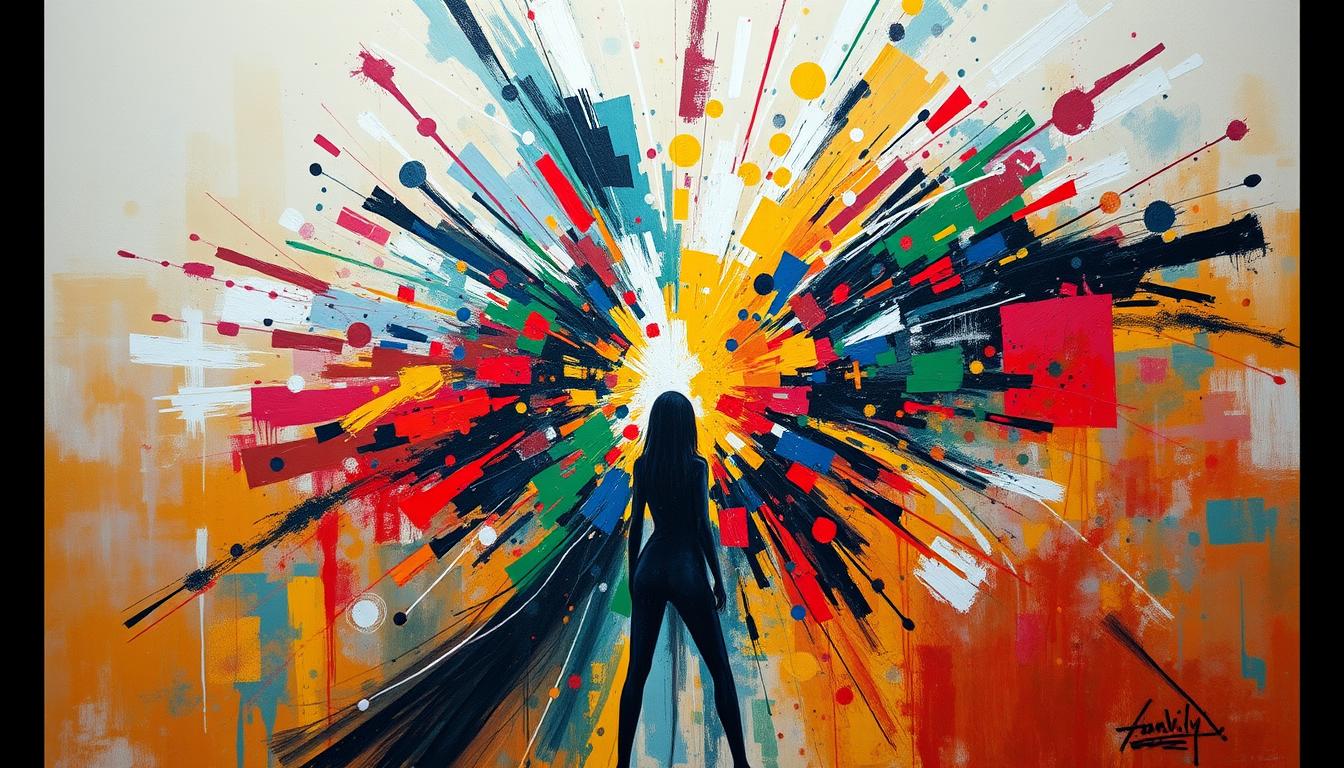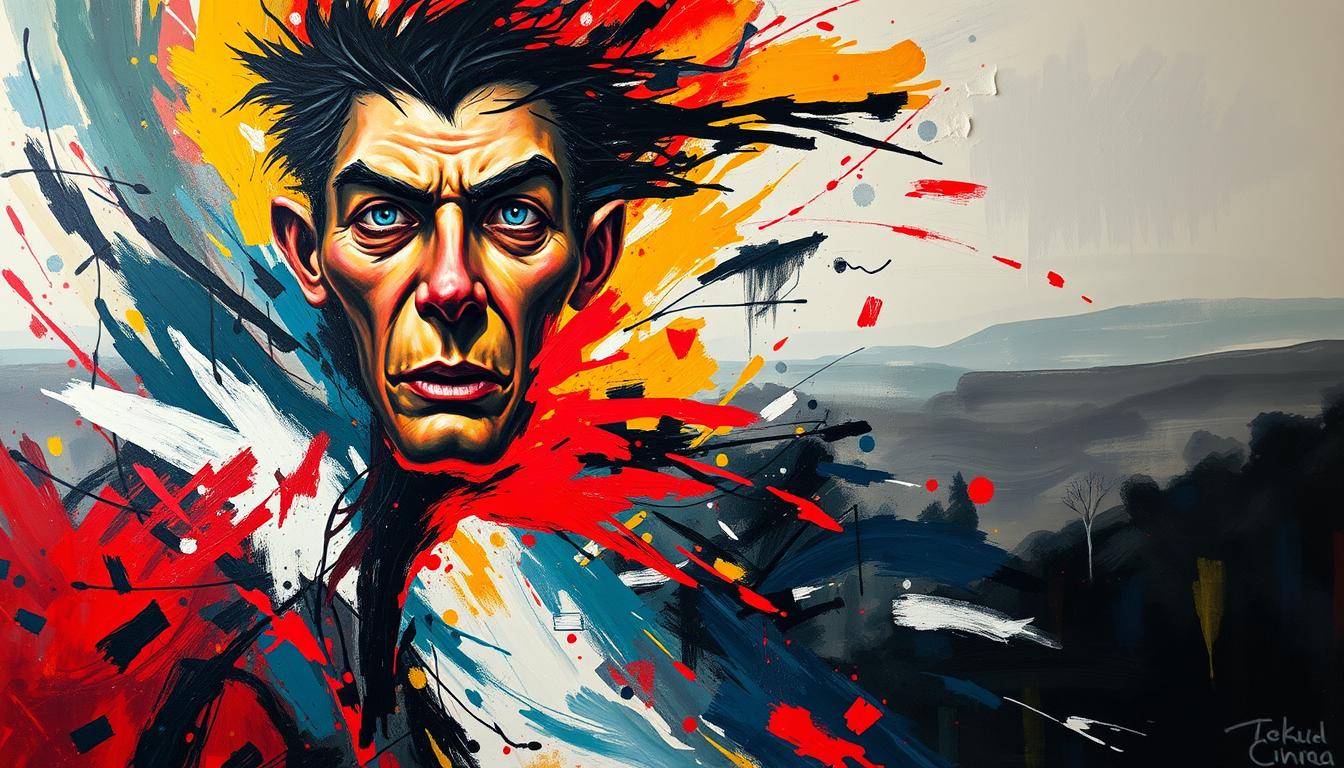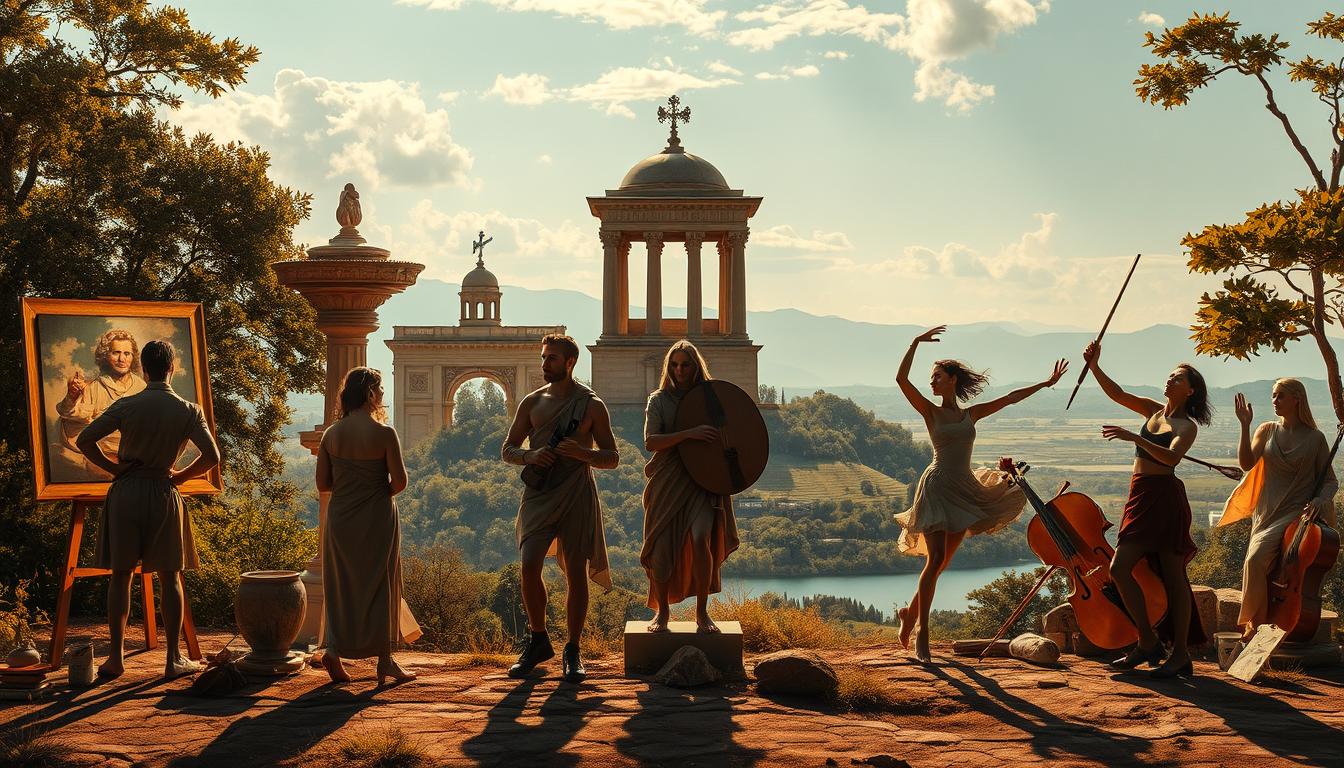Curious how wild color and stretched forms can reveal a person's inner life? This guide cuts through jargon and shows how a bold style in art put feeling before facts.
At its heart, expressionism champions raw emotion. Artists used distortion, fierce color, and jagged lines to make viewers feel rather than to copy reality.

This movement grew from late 19th-century roots and took shape across Germany, Austria and beyond. You will meet key groups like Die Brücke and Der Blaue Reiter, plus names such as Edvard Munch and Ernst Ludwig Kirchner.
Expect a clear, jargon-free tour from definition to history and influence. By the end, you will spot the hallmarks—bold colour, violent brushwork, twisted forms—and explain how this current changed the 20th century art world.
Key Takeaways
- Expressionism puts inner feeling before literal truth.
- Look for vivid colour, jagged lines, and distorted figures.
- Roots trace to late 19th-century artists like Munch and Van Gogh.
- German groups Die Brücke and Der Blaue Reiter shaped the movement.
- The style influenced cinema and later currents such as Abstract Expressionism.
- By the end you’ll spot and explain key features with confidence.
What is Expressionism in simple words?
Some painters stretched shapes and dialled up colour so the mood comes through first. This approach puts inner response above literal sight.
Expressionism shows how a scene makes the artist feel rather than how it looks in cold reality. Artists use distortion, exaggeration, primitivism and bold marks to make those feelings obvious.
The style began as a broad modern current and as a distinct pre-World War I movement among German and nearby artists. It grew as a reaction to the limits of copying the eye.
Work often looks intense because colour, line and form get amplified. Technique plays second fiddle to direct, personal impact. Paintings, prints, sculpture and more all centre an artist’s inner life.
If something looks odd or raw, that choice can be the point. The next section will show key features to spot when you look at expressionist work.
| Feature | How it appears | Why it matters |
|---|---|---|
| Colour | Vivid, clashing hues | Conveys emotional tone fast |
| Line and Form | Jagged, stretched, simplified | Makes feeling more visible than shape |
| Technique | Rough, spontaneous marks | Prioritises impact over polish |
| Scope | Painting, printmaking, sculpture | Applies feeling across media |
Key hallmarks of Expressionist style: color, line, and feeling
Colour, mark-making and angled space work together to make emotion the main subject. Expressionism favors feeling over faithful depiction, so every choice serves mood.
From vivid, jarring color to jagged, distorted forms
Vivid, jarring colour often replaces natural hues in paintings and prints. These tones set a mood fast—shock, sorrow, or rage—before you read details.
Jagged, distorted lines and rough, rapid brushwork make images tense and urgent. Such marks let viewers feel pressure, not just see it.
Artists used exaggeration and fantasy to capture inner storms rather than mimic reality. Crowded composition, tilted perspectives and skewed space add instability.
Woodcuts deserve a special mention. Carved, thick lines and stark contrasts sharpen the emotional punch in many works and images.
- Checklist: bold colour, broken line, visible brushwork, skewed space.
| Feature | How it shows | Why it matters |
|---|---|---|
| Colour | Clashing, non-natural hues | Conveys mood instantly |
| Line | Jagged, warped contours | Creates tension and motion |
| Surface | Rough brushwork, carved marks | Feels direct and alive |
Bottom line: the expressionist style is an approach that makes viewers feel first, then think. Spot these cues and you will read expressionist art with fresh eyes.
Where Expressionism came from: late 19th roots to early 20th century breakout
Artists at the turn of the century turned dramatic colour and warped form into tools for mood. These experiments began around 1885–1900 and sowed the seeds for a broader movement by the early 20th century.
Precursors who changed the game
Vincent van Gogh pushed paint into feverish swirls so nature acted like a mirror of feeling. His work made landscapes and skies feel alive with emotion.
Edvard Munch and James Ensor used stark line and grotesque imagery to show fear and alienation. Their prints and paintings felt urgent and personal rather than polite or decorative.
Why the world pushed artists to react
Rapid urban growth, new technologies, and social unrest made many artists seek deeper truths. This reaction to modern life turned representation into a means to reveal inner states.
The tense prewar mood in Europe made intense art feel urgent. As these ideas coalesced in Germany, scattered experiments became a recognisable scene with shared aims.
| Phase | Key feature | Why it mattered |
|---|---|---|
| Late 19th | Colour as emotion | Nature becomes charged and hallucinatory |
| Turn of century | Distortion and grotesque | Expresses fear, anxiety, psyche |
| Early 20th | Groups and manifestos | Movement gains shape and momentum |
German Expressionists and the rise of Die Brücke and Der Blaue Reiter
Two vibrant coalitions in Germany pushed painting and printmaking toward raw personal vision. These groups offered distinct paths but shared a drive to make feeling visible.

Die Brücke: a Dresden circle of shock and urgency
Die Brücke formed in 1905 under Ernst Ludwig Kirchner’s lead. Members such as Emil Nolde and Karl Schmidt-Rottluff joined a band of young artists who rejected academic polish.
They drew on African carvings and northern masters to fuel jagged distortion, rough brushwork, and acidic palettes. Urban scenes felt raw, immediate and often confrontational.
Der Blaue Reiter: colour, form and a turn toward abstraction
Der Blaue Reiter, centred around Wassily Kandinsky, favoured lyrical, abstract explorations. This circle pursued spiritual concerns and formal problems alongside emotion.
Media and methods: painting, woodcuts, and brushwork
Woodcuts gave both groups bold lines and stark contrast. Rough brushwork and carved marks matched their message: medium and meaning aligned.
"Art must be an expression of inner necessity."
| Group | Leaders | Visual traits |
|---|---|---|
| Die Brücke | Ernst Ludwig Kirchner | Jagged forms, harsh colour, urban grit |
| Der Blaue Reiter | Wassily Kandinsky | Lyrical colour, move toward abstraction |
| Shared | Various artists | Spontaneity, spiritual urgency, bold printmaking |
Artists to know and their emotionally charged works
A handful of figures reshaped portraiture and landscape so emotion reads like a map. Their paintings act as direct channels for anxiety, recovery and inner life.
Edvard Munch’s The Scream and the language of anxiety
Edvard Munch made inner terror visible in The Scream (1893). The figure’s open mouth, swirling sky and rhythmic lines turn panic into a visual sentence.
This work shows how emotionally charged art can speak before words do. Look for color that vibrates and line that pulses.
Ernst Ludwig Kirchner’s Winter Moonlit Night and a turn to nature after war
Ernst Ludwig Kirchner (often shown as ludwig kirchner) retreated to the Swiss Alps after the war. In Winter Moonlit Night (1919) calm blues and a red sky suggest recovery and refuge in nature.
The painting blends meditative mood with bold harmony. It also echoes the group’s love of woodcut clarity and force.
Egon Schiele and Oskar Kokoschka: raw portraits, figures, and inner life
Egon Schiele made taut, raw portraits that expose nerves and vulnerability. His figures refuse polish and instead reveal feeling.
Oskar Kokoschka used urgent brushwork and symbolic detail to turn sitters into psychological landscapes. Both artists pushed portraiture toward confession.
- These artists and their works show how mood, body and color unite.
- Look for rhythmic lines, intense palettes and charged poses as clues to emotionally charged intent.
- Emil Nolde adds vivid colour and powerful figures to complete the spectrum.
| Artist | Key work | What to notice |
|---|---|---|
| Edvard Munch | The Scream (1893) | Swirling sky, rhythmic lines, visible anxiety |
| Ernst Ludwig Kirchner | Winter Moonlit Night (1919) | Blue glow, red sky, nature as refuge |
| Egon Schiele | Portraits and figure studies | Tense poses, raw vulnerability |
| Oskar Kokoschka | Psychological portraits | Urgent brushwork, symbolic detail |
How Expressionism differs from Impressionism—and why it mattered
One style studies sunlight and atmosphere; the other probes mood and memory.

Impressionism captures light, fleeting colour and the seen world. It keeps forms close to observed reality and records a moment outdoors.
Expressionism, by contrast, bends shape and pumps up colour to share inner feelings. In painting this means broken forms, jagged lines and dramatic hues that signal emotion.
This pivot mattered because it opened a path beyond optical truth. Artists who favoured feeling made room for abstraction and experimental approaches that reshaped 20th-century art.
The viewer’s experience shifts too. An Impressionist scene feels atmospheric and observed. An expressionist canvas feels urgent, subjective, and direct.
- Quick tip: if a work looks like a record of light, think Impressionism; if it looks like a mood made visible, think expressionism.
| Focus | Impressionism | Expressionism |
|---|---|---|
| Truth sought | Optical | Psychological |
| Approach | Surface light | Inner feeling |
| Impact | Atmosphere | Urgency |
Beyond painting: German Expressionism in cinema and the road to Abstract Expressionism
German Expressionist cinema turned sets and lighting into a language of mood and dread. Directors in the Weimar Republic used angled architecture, painted backdrops, heavy makeup and stark contrast to make audiences feel a character’s inner state.
From The Cabinet of Dr. Caligari and Nosferatu to Film Noir and Hollywood
The Cabinet of Dr. Caligari (1920) and Nosferatu (1922) show how skewed sets and eerie shadows became a film grammar. Fritz Lang’s Metropolis and M deepened psychological drama and visual scale.
When filmmakers and technicians left Europe after a troubled time and world war pressure, Hollywood absorbed their techniques. The same visual cues informed Universal monster images and the chiaroscuro of later film noir.
After the wars: Neue Sachlichkeit and the legacy into the 20th century
After world war upheaval, some artists shifted toward Neue Sachlichkeit, a realist response that sharpened social critique. Yet the emotional priorities of the earlier group survived.
The throughline from these screen images reached painting and beyond. Expressionist artists and directors helped prepare an appetite for gesture and inner states that later fed Abstract Expressionism. By the mid-century, the emphasis on feeling and bold mark-making crossed back into international studio practice and global art vocabularies.
| Area | Key traits | Impact |
|---|---|---|
| Cinema | Angular sets, stark lighting | Made emotion legible on screen |
| Migration | Émigré talent to Hollywood | Shaped monster films, noir |
| Post-war art | Neue Sachlichkeit, then abstraction | Led toward Abstract Expressionism |
Conclusion
A new visual language let artists translate anxiety, joy and doubt into paint and woodcut.
Expressionism remains a style and movement that turns inner life into visible form. Die Brücke’s raw energy and Der Blaue Reiter’s move toward abstraction show how groups and individual creators shaped this vision.
The movement crossed media—painting, printmaking and film—all sharing colour intensity, jagged line and bold distortion as quick identifiers for viewers. These clues help you read works and spot expressionist artists at a glance.
From van gogh and Vincent van Gogh’s legacy to Wassily Kandinsky and many later expressionists, the century-long influence is clear. Visit museums, watch classic films, and read books to see how this group of artists still speaks to life’s inner weather.
Enhance Your Space with Unique Modern Masterpieces
Are you inspired by the innovative mediums and conceptual depth highlighted in our exploration of contemporary art? You’re not alone! Today’s art enthusiasts are seeking cultural relevance and emotional connections in their artwork. However, finding pieces that resonate with modern themes and fit your unique style can be a challenge. That’s where we come in!
At Rossetti Art, we specialize in canvas prints, original paintings, and modern sculptures that celebrate the spirit of now. Each piece created by Chiara Rossetti brings a personal touch that connects deeply with current social narratives—just like the modern masterpieces discussed in the article. Don’t miss out on the chance to elevate your home decor with breathtaking artwork that speaks to your values and aesthetic. Explore our collection today and find your perfect piece! Act now, and transform your space into a gallery of inspiration!
FAQ
What is the core idea behind Expressionism?
Expressionism focuses on showing strong inner feelings rather than copying reality. Artists stretched color, line, and form to express emotion, anxiety, or spiritual states. This made images look intense, often distorted, to push a viewer toward feeling rather than just seeing.
Which artists helped start the movement?
Pioneering figures include Vincent van Gogh, Edvard Munch, and James Ensor. Their bold color choices and dramatic brushwork influenced early 20th-century groups in Germany and Austria, who developed those approaches into a full movement.
How do color and line work in this style?
Color often reads vivid or jarring to amplify mood. Lines can bend, break, or jag outward to create tension. Together they make scenes feel urgent and emotionally charged, whether in portraits, cityscapes, or landscapes.
Where and when did Expressionism grow most strongly?
The movement grew after the late 19th-century roots and became prominent in the early 20th century, especially in Germany and Austria. Social change, industrialization, and pre–World War I tensions helped fuel a need for art that reacted to modern life.
Who were the German groups Die Brücke and Der Blaue Reiter?
Die Brücke formed in Dresden and included Ernst Ludwig Kirchner, Emil Nolde, and Karl Schmidt-Rottluff, known for raw energy and woodcuts. Der Blaue Reiter gathered around Wassily Kandinsky and favored more spiritual, abstract directions in painting.
What kinds of media and techniques did Expressionists use?
Painters used oil, tempera, and aggressive brushwork; printmakers favored rough woodcuts. The goal was immediacy—visible strokes, simplified shapes, and high-contrast prints that carried emotion directly to the viewer.
Which works best show the movement’s emotional force?
Iconic pieces include Edvard Munch’s The Scream for existential dread, Ernst Ludwig Kirchner’s Winter Moonlit Night for postwar nature and recovery, and Egon Schiele’s raw portraits that expose psychological vulnerability.
How does this style differ from Impressionism?
Impressionism records light and momentary effects of nature with soft color and loosened brushwork. Expressionism flips that aim: it distorts reality to prioritize subjective emotion over optical truth.
Did Expressionism influence cinema and later movements?
Yes. German Expressionist films like The Cabinet of Dr. Caligari and Nosferatu used stylized sets and shadow to evoke fear and alienation, shaping film noir and horror. Later, Abstract Expressionism in the mid-20th century drew on the emphasis on gesture and inner life.
How did world events affect Expressionist artists?
War, urban change, and political unrest pushed many artists to confront trauma and instability. Some, including Kirchner, reacted to wartime experience by seeking new connections with nature and community after conflict.
Which other notable artists are linked to the movement?
Important names include Emil Nolde, Oskar Kokoschka, and Egon Schiele, plus Kandinsky and members of the Blue Rider circle. Their works span raw portraiture, mystical abstraction, and socially critical scenes.






Leave a comment
This site is protected by hCaptcha and the hCaptcha Privacy Policy and Terms of Service apply.